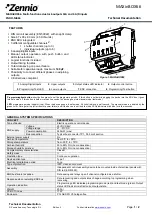
Page 12 Track section module MX9
APPLICATION EXAMPLE –
Module-autonomous block control
In contrast to the previous examples, here the main sections of the MX9 are linked to each other.
The status of a signal influenced block (whether it is set to “stop” or “go”) depends on the occupancy
state of the following block.
The mode of action when trains are stopped inside a block is identical to the previous examples (in-
cluding when pusher trains are involved).
Automatic block control, which is the usual operating mode and is indicated by yellow keyboard
LED’s on the cab, can be overridden to issue a “Stop” (red LED) or “Go” (green LED) command to
any block by pressing the relevant key on the cab or by switches connected to the MX9 (with
MX9ASE boards plugged-in).
Block control can be laid out cyclically, that is the last block depends on the state of the first block
(see example below), but may also end in a manually controlled signal influenced block or in an entry
block to a staging yard.
Applicable CV settings for this example (Signal influenced block at main section 3 of the MX9):
CV # 21 = 40 (Stopping with L-H, because block 1 is longer in this example)
CV # 22 = 30 (Stopping with U-H, because the stop section here is shorter)
CV # 23 = 31 (The ones digit in the value “31” defines a cyclical dependency of block 1)
CV # 2, 3, 4 = .... optional: for limited speed when “green” and in opposite travel direction;
see “Initial speed limits” in the CV table above.
CV # 29, Bits 1.0 = 00 if “OCC. INDICATORS” socket is empty or used for occupancy detection
= 01 if socket is used for signals in opposite direction
= 11 if socket is used for external switch inputs (ASE plugged in)
BLOCK 1
Common GROUND,
track power
and
CAN bus
from command station
MX9
with MX9ALA b oards
with MX9ASE b oards
Continue !
Green
Slow dow n !
Continue !
BLOCK 2
BLOCK 3
BLOCK 1
Non-stop !
Stop section
Stop section
external
sw itches
When signals are used
w hen sw itches are used
Red
Stop !
Stop section
The same example but with bidirectional block control using the same sections:
If block control for the track sections in this example should also be possible in the opposite direction,
then the CV’s need to be programmed for this mode.
CV # 21 = 143 (The ones digit in the value „143“defines a cyclical dependency of block 3)
CV # 22 = 130
CV # 23 = 130
CV ‚ 29, Bits 1, 0 = 01 as mentioned above, for signals in opposite direction
APPLICATION EXAMPLE –
Module autonomous staging yard
This block in detail looks as follows:
Track power
from command
station
Signal switch
for
driving
direction.
left
Green
Signal switch
for
driving
direction.
right
MX9
With p lug- in MX9ASE
External switches or relays that
simultaneously actuate signals
and MX9 inputs. Actuation with
the cab is also possible instead.
Green
CV # 21 = 30 Station entry block with signal
CV # 22 = 51 (first track in staging yard, pin #1 for turnout actuation)
CV # 23 = 53 (second track in staging yard, pin #2 for turnout actuation)
CV # 24 = 54 (third track in staging yard, pin #3 for turnout actuation)
CV # 25 = 30 Block following the staging yard
CV # 3, # 4, # 5 = 23 (this as an additional definition to CV #21, #22 and #23, not as main defini-
tion as is normally the case):
That is, trains in direction A->B are to drive through with speed limit L (=2) if signal is
green but trains traveling from B->A are to drive without speed limit (=3).
Signals for A->B can be connected to socket SIGNALS (if MX9ALA are plugged in);
Switches for actuating a route can be connected to the socket SIGNALS if MX9ASE is installed; this
excludes signals from being plugged in at the same time.
The individual track sections can also be controlled by the cab; LED above key is yellow if in normal
mode (=automatic), switching LED to red or green overrides automation and forces the signal to its
corresponding state.
OTHER PARAMETERS FOR THE OPERATION OF HIDDEN STATIONS?
CV’s for hidden stations (fiddle yards)
HAS NOT BEEN FINALIZED YET!
Содержание MX9V
Страница 22: ...Page 22 Track section module MX9 ...








































